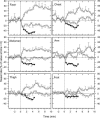The distribution of cutaneous sudomotor and alliesthesial thermosensitivity in mildly heat-stressed humans: an open-loop approach
- PMID: 15760945
- PMCID: PMC1464483
- DOI: 10.1113/jphysiol.2004.081562
The distribution of cutaneous sudomotor and alliesthesial thermosensitivity in mildly heat-stressed humans: an open-loop approach
Abstract
The distribution of cutaneous thermosensitivity has not been determined in humans for the control of autonomic or behavioural thermoregulation under open-loop conditions. We therefore examined local cutaneous warm and cool sensitivities for sweating and whole-body thermal discomfort (as a measure of alliesthesia). Thirteen males rested supine during warming (+4 degrees C), and mild (-4 degrees C) and moderate (-11 degrees C) cooling of ten skin sites (274 cm2), whilst the core and remaining skin temperatures were clamped above the sweat threshold using a water-perfusion suit and climate chamber. Local thermosensitivities were calculated from changes in sweat rates (pooled from sweat capsules on all limbs) and thermal discomfort, relative to the changes in local skin temperature. Thermosensitivities were examined across local sites and body segments (e.g. torso, limbs). The face displayed stronger cold (-11 degrees C) sensitivity than the forearm, thigh, leg and foot (P = 0.01), and was 2-5 times more thermosensitive than any other segment for both sudomotor and discomfort responses (P = 0.01). The face also showed greater warmth sensitivity than the limbs for sudomotor control and discomfort (P = 0.01). The limb extremities ranked as the least thermosensitive segment for both responses during warming, and for discomfort responses during moderate cooling (-11 degrees C). Approximately 70% of the local variance in sudomotor sensitivity was common to the alliesthesial sensitivity. We believe these open-loop methods have provided the first clear evidence for a greater facial thermosensitivity for sweating and whole-body thermal discomfort.
Figures





References
-
- Attia M, Engel P. Thermal alliesthesial response in man is independent of skin location stimulated. Physiol Behav. 1981;27:439–444. 10.1016/0031-9384(81)90329-2. - DOI - PubMed
-
- Benzinger TH. Role of thermoreceptors in thermoregulation. In: Zotterman Y, editor. Sensory Functions of the Skin in Primates, with Special Reference to Man. Oxford: Pergamon Press; 1976. pp. 379–397.
-
- Bothorel B, Galeou M, Dewasmes G, Hoeft A, Candas V. Leg skin temperature and thigh sweat output: possible central influence of local thermal inputs. Eur J Appl Physiol. 1991;62:405–409. - PubMed
-
- Brown GA, Williams GM. The effect of head cooling on deep body temperature and thermal comfort in man. Avat Space Environ Med. 1982;53:583–586. - PubMed
-
- Burke WE, Mekjaviæ IB. Estimation of regional cutaneous cold sensitivity by analysis of the gasping response. J Appl Physiol. 1991;71:1933–1940. - PubMed
Publication types
MeSH terms
LinkOut - more resources
Full Text Sources
Other Literature Sources
Medical

